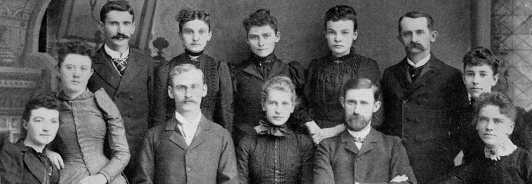Submit a Class/Book Note entries are limited to books published within the last year.
Amanda Rose Adams (BA-98) raises awareness of congenital heart disease, the world’s most common and lethal birth defect, through an emotionally powerful personal story. Five months into her pregnancy, Adams learned her baby was missing half of his heart. She and her husband, Jim, were forced to choose between terminating the pregnancy or embracing uncertainty. Heart Warriors: A Family Faces Congenital Heart Disease follows Adams through the 12 surgeries it takes to keep Liam alive while they face an uncertain future. She deals with the reality of having a child with congenital heart disease and the struggles of raising her younger daughter while her son fights for his life. Adams has since become an advocate, speaking before the Colorado Legislature and helping spearhead new screening studies for heart patients. She has also formed two congenital heart disease nonprofit organizations, organized medical conferences for Hypoplastic Right Hearts, attended medical advisory board meetings and national chapter meetings for the Children’s Heart Foundation, and chaired the Congenital Heart Walk in Colorado. The book also includes resources for parents and families in similar situations. The story is about hope, Adams says. “If this book shows one family that they are not alone, or convinces one nurse how important she really is, or steers one medical student to pediatric cardiology, then it was worth it,” she says in an online video promoting her book.
The Color of Darkness, written by Michael Bierwiler (MA-79), Bedford, Texas, was a finalist in the North Texas Book Festival in April 2011. Michael’s two decades of law enforcement experience on one of the largest police departments in Texas brings the characters in the book to life. He graduated from the Law Enforcement Management Institute of Texas at Sam Houston University and holds Master’s certification from the Texas Commission on Law Enforcement Officer Standards and Education. Michael has authored three other novels, Mist on the River, Living in Quiet Rage and Hiding in the Shadow of Heaven.
Martin Buinicki (BA-95, MA-97), Valparaiso, Ind., is the author of Walt Whitman’s Reconstruction: Poetry and Publishing between Memory and History, an account of Whitman’s postwar writing. Martin is the Walter G. Friedrich Professor of American Literature at Valparaiso University.
Mark Danielson (BA-70), Thornton), published his fourth novel, Writer’s Block, a suspenseful crime novel that introduces Fort Worth homicide detective Maxx Watts. Mark is a pilot for FedEx.
Deirdre (White) Jones (BA-95), Greeley, has created Elderbooks, read-aloud picture books for the elderly. Elderbooks is an activity that is both familiar and repetitive, two important elements for Alzheimer’s and dementia patients. Deirdre’s first book, Something About That Smile, is the story of two childhood friends who are reunited at a care facility late in life. The second book, The Umbrella Man, is a metaphorical look at how an elderly man takes on life’s storms. Committed to finding a cure, Deidre donates 10 percent of every picture book purchased to the Alzheimer’s Association.
Wicked Autumn, a novel by G.M. Malliet (BA-78) Alexandria, Va., is the first of a mystery series centered on Max Tudor, former M15 agent turned Anglican priest. G.M.’s first book in the DCI St. Just mysteries series was chosen by Kirkus Review as one of the Best Books of 2008.
Allyson Raphel (BS-91) lived in a silent world before receiving a cochlear implant at the age of 30 after the birth of her second son.
Raphel’s book, Turning a Deaf Ear, shares the ups and downs of “new life” in a foreign, and very loud world. Prior to the surgery, Raphel was considered “profoundly deaf.” Afterwards, her hearing status was raised to “hard of hearing.”
“A multitude of sounds assaulted me — it was indescribable,” Raphel says. “Water rushing out of a faucet into a bathtub is still something I can’t stand.”
The sweet sound of birds chirping and music — especially the flute — are the most soothing
sounds, she says.
Ten years after the surgery, Raphel is able to adapt more quickly to the noises around her. Some people believe the transition after receiving the cochlear implant is similar to flipping a switch — a common misconception of the surgery. Turning a Deaf Ear disproves that theory in more ways than one.
“The process is emotional and arduous,” Raphel says. “The book provides an opportunity for anyone who may have full hearing and/or sight to truly understand what it is like to have such a disability and perhaps realize how wrong preconceived notions just might be.”
I Must Survive, a novel Alzheimer’s Association. written by Harry Simpson (BS-68), Winter Haven, Fla., is the story of a lone survivor of a brutal attack on a U.S. patrol boat during the Vietnam War. Throughout Harry’s life, he experienced his own forms of survival — polio, cancer, a spinal blockage and blood clots. He now enjoys retirement with his pets and friends after a 39-year career in finance.
Tom Sturm (BA-91), Easthampton, Mass., is a journalist at a weekly newspaper and monthly news/arts magazine in western Massachusetts. He has written two novels, three featurelength screenplays and approximately 200 rock/ pop songs. Samantha Smart: Time Traveler, Tom’s most recent book, is a young adult novel that follows the adventures of an 11-year-old Brooklyn girl through time.
Command Sergeant Major (Retired) Curtis Tipton (BA-70, MS-91), Sierra Vista, Ariz., completed an illustrated children’s alphabet book from the War for Southern Independence. A is for Army is based on a song sung by soldiers, both Gray and Blue. Curtis’s grandfather learned the song from his father and sang “A is for Army” to him when he was a child.







